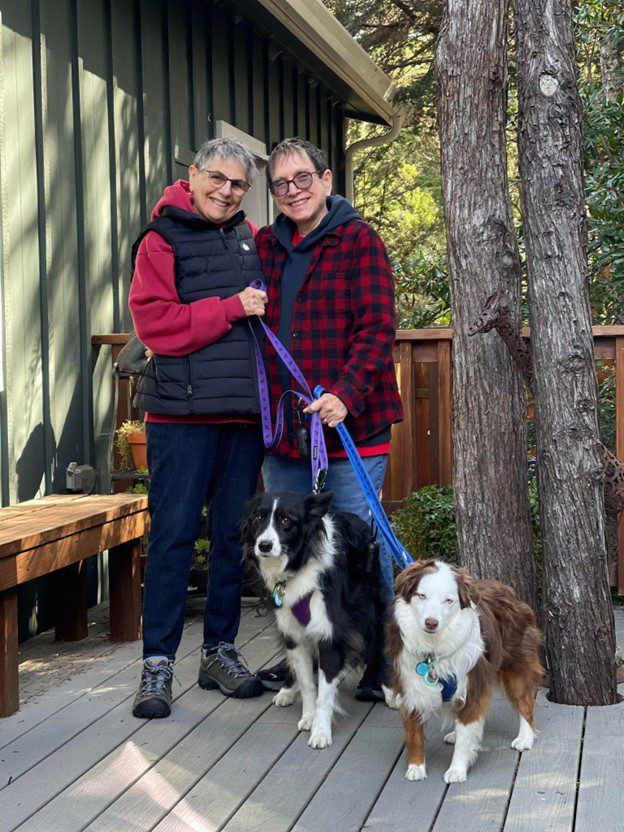
It was one of the most challenging choices Linda Shear and windflower Townley (Townley spells her first name with a small w) say they ever had to make: Who would they hire to drive their two dogs, Emma and Skylar, across the country?
“We had to move from California to Massachusetts,” Shear says. “At first, we thought we would drive them in our car, but we realized it was just too far. We don’t like long-distance driving.”
They decided to fly, but their dogs were too large to fit in the plane’s cabin, and the couple didn’t want them to fly in the cargo hold.
So, they tried to find a reputable dog transport service. “It was really stressful,” Townley says. “We looked for weeks to find people we could rely on that offered a reasonable service at a reasonable price.”
They interviewed a couple of pet moving services, but after some quick internet sleuthing, they discovered horror stories. A dog died from heat exhaustion while in the care of one company they spoke to, and a driver for another was facing charges for causing a hit-and-run accident.
“It’s scary because, to us, our dogs are family,” Shear says. “I feel like we dodged a couple of bullets by taking the initiative to do some research.”
How do you find a trustworthy dog moving company? It’s essential first to understand how the system works.
The Rules of the Road

Anyone hired to transport, handle, or hold dogs in connection with their trip must register with the U.S. Department of Agriculture (USDA) as a carrier or handler. This includes large pet transportation services with multiple vehicles and employees as well as individual drivers with a van who operate their own pet moving companies.
However, the registration process doesn’t include animal or transport competency tests, criminal background searches, or driving history checks. Commercial driver’s licenses are not required; neither is knowing pet CPR, first aid, or having dog handling skills.
As part of the registration process, companies agree to obey the Animal Welfare Act (AWA), which sets regulations and standards for transporting and handling dogs. There are rules about feeding, housing, sanitation, ensuring dogs have adequate and secure crates, proper ventilation, and common-sense procedures like keeping aggressive dogs away from other animals.
But animal welfare experts say they are concerned about gaps in the regulations. “They only require carriers to clean urine and feces once every 24 hours, provide water once every 12 hours, and there are no required rest (bathroom) breaks for dogs,” says Morgan Boutilier, an attorney with the Animal Legal Defense Fund.
Unless a transporter gets pulled over by police or a major problem occurs, like a breakdown or a sick dog, no one outside the company may know what happens during a road trip.
The rules do allow the USDA to conduct unannounced inspections of companies’ facilities and take action if the businesses violate the AWA. You can check a pet transporter’s inspection and violation history and verify they’re registered on the agency’s website.
Though the USDA accepts and investigates complaints about pet transportation services, the feds don’t post those complaints–or even the number of complaints a company has–online. To find that out, you must submit a Freedom of Information Act (FOIA) request, which can take 20 days to get a response and that response may not contain the information you need.
Growing Need for Safe Ground Dog Transport Services

Some in the pet transport business are calling for improvement in the industry, government regulation, and ways to make it easier for pet parents to find qualified movers to take their animals on the road.
“There are reputable companies, but the onus is on the individual that will be trusting their beloved pet family member to a transporter,” says Elizabeth Schuette, president and CEO of The Ark at JFK, a pet transportation company.
Schuette is also on the Animal Transportation Association (ATA) board of directors and a member of the International Pet and Animal Transportation Association (IPATA). Both professional organizations have standards and ongoing education for pet movers. IPATA has strict requirements for active members, including providing proof of their insurance, letters of recommendation, and taking a proficiency test.
But Schuette says she’d like trade groups to create special requirements and certifications specifically for companies transporting dogs by ground. These pet movers are in high demand because airlines are increasing restrictions on dogs flying in the cabin, and many dogs can’t tolerate flying in the cargo hold due to their breed (like brachycephalic dogs), behavior, health, and safety concerns.
“There’s a whole new business opportunity in ground transportation for pets, and it’s really a fledgling market,” Schuette says. “There’s a lot that goes into it and if you did engage a ground transporter, you could be confident that if they had these certifications, you were putting your dog in safe hands.”
Dog Transport Service Cost
If you do an internet search for pet transportation companies, you’ll see large and small businesses and brokers who offer your dog moving needs to different drivers who bid on giving your pup a lift.
Some movers use their own cars, others rent vehicles or mini-vans, and some have corporate fleets.
Many companies offer group or shared transports with other dogs. The price is often based on the size of your dog, their medical or behavioral needs, and length of the journey. Shared rides range from about $700 to $3000. Usually, these movers run weekly or monthly routes and pick up and drop off your dog along the way.
Some businesses offer private transport for your dog, which might cost from $1.75 to $3.00 or more per mile, depending on the services you request.
“If someone doesn’t want their dogs around other dogs, or they feel their dog is aggressive and can’t be with others, they ask us if we could just send an individual to pick up their dog and drive them,” says Mogeb Alomari, who owns Animal Logistics pet transport services.
Alomari’s company offers group and private rides. He drove Shear and Townley’s dogs across the country in the couple’s car as they flew to Massachusetts.
He tries to cater to his customers’ needs and offers relocation services for military members, rescue groups, breeders, and VIPs.
“We have athletes, we have celebrities, and usually their managers contact us and say, ‘During the off-season, they’re moving back to North Carolina,’” Alomari says. “I’d say that would cost anywhere from $4,000 to $8,000 depending on how many dogs and what the client wants. Some say, ‘I want you to rent an Airbnb every night and stay with my dogs.’ So, we have to factor all this in.”
Is Your Dog Right for a Road Trip?
Before hiring any pet transporter, you need to ask yourself tough questions, starting with: Is your dog the transporting kind?
It’s important to be brutally honest with any mover you interview and tell them about your pooch’s quirks:
- Has your dog bitten or snapped at anyone? What were the circumstances?
- How does your dog react to being handled by strangers?
- Does your dog have health problems? Or anxiety?
- Does your dog get car sick?
- Is your dog fearful or a flight risk?
- How is your dog in a crate?
- Does your dog get along with other dogs?
You want to avert disaster and not put your dog or a driver at risk.
“We do a full evaluation of the client, a behavioral assessment of the dog, and make sure we have the right driver lined up to make the trip,” Alomari says. “There’s a lot that goes into making a trip successful.”
Before your dog goes on transport, they’ll need proof of a current rabies vaccination, an exam, and health certificate from a veterinarian.
Many transporters also recommend that dogs be up to date on parvo, distemper, leptospirosis, and kennel cough vaccinations. Your dog will be out of their usual environment and might be exposed to other animals during the trip, even stopping at rest areas to relieve themselves. Some states your dog travels through may also have specific vaccine requirements.
Make sure your dog is microchipped and your contact information with the chip company is up to date.
How to Choose a Pet Moving Service

To choose the right pet moving service, put on your pet detective hat and jump online. Ensure any company you consider is registered with the USDA and check out their violation history and inspection history. Google the company’s name and see what you can find. Search the Better Business Bureau’s website and even social media for complaints.
Check the ATA and IPATA listings of members who provide ground transport.
Once you contact a company, ask lots of questions. “Ask what their safety record is when it comes to driving? What is their contingency plan if a breakdown happens? Or their AC goes out? They need a plan in place. If someone says, ‘I can’t afford to fix this,’ or ‘I’ll call a tow truck,’ that’s what leads to disasters happening on the road with people’s pets,” Alomari says.
Other questions to ask a pet moving company:
- What kind of vehicle would be used for your dog’s trip?
- Is the vehicle climate-controlled?
- Is there a fire and CO detector in larger-sized vehicles or trailers?
- How often do they check on the dogs?
- How often do they offer dogs food and water?
- How often do they walk the dogs, and where?
- What dog-handling experience do the drivers have?
- What is the process for removing animals from their travel crate for relief purposes or an overnight stay?
- Is the transporter experienced in controlling that environment?
- How long is each driver behind the wheel?
- Where and when will the drivers sleep?
- Will the dogs ever be unattended?
- Do the handlers know dog CPR and first aid?
- What is the dog-to-handler ratio?
- Do they have liability insurance if something happens on the trip?
Shear and Townley hired Alomari to drive their dogs to Massachusetts only after an extensive interview process in which they asked many questions.
Emma and Skylar arrived safely on the East Coast the same day the couple’s flight landed. They say their dogs had the road trip of a lifetime traveling with Alomari and staying at hotels along the way.
They’re so relieved their story has a happy ending; they did their research, and trusted their instincts.
“The fact that anybody with a van can do this, whether or not they have the competency and the capacity to get your animals somewhere safely, means you have to do your homework,” Shear says. “It’s better to regret that you put too much time into the vetting than to regret that you did not.”


